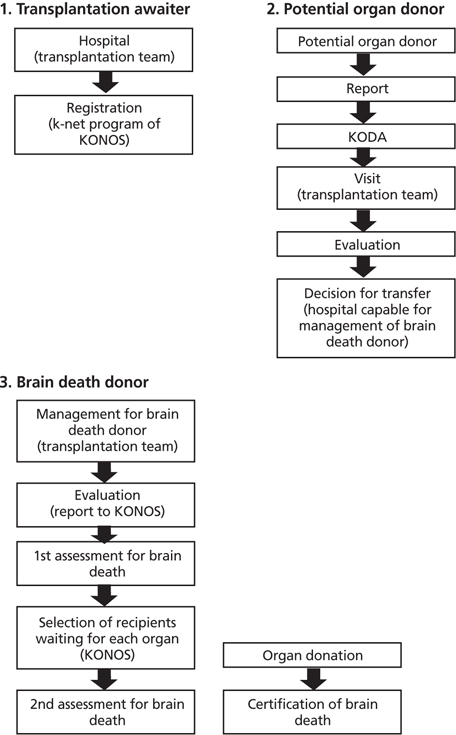J Korean Med Assoc.
2014 Feb;57(2):137-142.
Management of brain-dead donors in Korea
- Affiliations
-
- 1Department of Anesthesiology and Pain Medicine, Seoul St. Mary's Hospital, The Catholic University of Korea College of Medicine, Seoul, Korea. jiyo1004@catholic.ac.kr
Abstract
- Brain death is the irreversible end of all brain activity including involuntary activity necessary to sustain life. Since the first organ transplantation from a brain-dead donor in 1979, organ transplantation has been developing continuously in Korea. The Organ Transplantation Act was enacted in February 2000, making brain-dead organ donation legal in Korea, and the Korean Network for Organ Sharing (KONOS) was simultaneously launched, permitting the organized procurement and distribution of organs. Once brain death is declared, aggressive fluid management, use of vasopressors, and mechanical ventilation should be maintained between brain death and organ donation to keep all other vital organs completely functional, providing optimal opportunities for organ donation.
Keyword
MeSH Terms
Figure
Reference
-
1. Russell T. Brain death. Intensive Care Med. 2004; 30:1697–1698.
Article2. A definition of irreversible coma. Report of the Ad Hoc Committee of the Harvard Medical School to Examine the Definition of Brain Death. JAMA. 1968; 205:337–340.3. Han SS, Kim JH, Hong HJ. A study on the organ transplantation according to the law of organs transplantation. J Korean Soc Transplant. 2003; 17:203–219.4. Choi KT, Lee YM, Seong KW, Lee C, Lee DM, Suh BT, Lee SG, Ha HS. An analysis of the clinical status of the brain death donors. Korean J Anesthesiol. 1998; 34:160–166.
Article5. Organ Procurement and Transplantation Network. OPTN/SRTR annual data report 2011 [Internet]. Rockville: Health Resources and Services Administration;cited 2014 Jan 17. Available from: http://optn.transplant.hrsa.gov/data/annualreport.asp.6. Korean Network for Organ Sharing. Annual data report 2012. Seoul: Korean Network for Organ Sharing;2012.7. Kim MS, Kim SI, Kim YS. Current status of deceased donor organ recovery and sharing in Korea. J Korean Med Assoc. 2008; 51:685–691.
Article8. Ministry of Health and Welfare. The laws of organs transplantation [Internet]. Seoul: Ministry of Health and Welfare;2010. cited 2014 Jan 17. Available from: http://www.mohw.go.kr.9. Andersen KS, Fox DM. The impact of routine inquiry laws on organ donation. Health Aff (Millwood). 1988; 7:65–78.
Article10. Kim MG, Jeong JC, Cho EJ, Huh KH, Yang J, Byeon NI, Yu JS, Bang KT, Chung HS, Ha JW, Kim SI, Cho WH, Ahn C. Operational and regulatory system requirements for pursuing self-sufficiency in deceased donor organ transplantation program in Korea. J Korean Soc Transplant. 2010; 24:147–158.
Article11. Kim BS, Kim YS, Kim SI, Kim MS, Lee HY, Kim YL, Kim CD, Yang CW, Choi BS, Han DJ, Kim YS, Kim SJ, Oh HY, Kim DJ. Outcome of multipair donor kidney exchange by a web-based algorithm. J Am Soc Nephrol. 2007; 18:1000–1006.
Article12. DuBois JM, Anderson EE. Attitudes toward death criteria and organ donation among healthcare personnel and the general public. Prog Transplant. 2006; 16:65–73.
Article13. Lee SM. Korean's cultural perspective and ethics of transplantation. J Ethics Educ Stud. 2005; 8:241–259.14. Kim SI, Min SI, Huh KH, Bang KT, Ahn C, Cho WH. The role of NGO in deceased organ transplantation. J Korean Soc Transplant. 2010; 24:1–3.
Article15. Korean Network for Organ Sharing. Work guide 2013. Seoul: Korean Network for Organ Sharing;2013.16. Wijdicks EF. Determining brain death in adults. Neurology. 1995; 45:1003–1011.17. Bugge JF. Brain death and its implications for management of the potential organ donor. Acta Anaesthesiol Scand. 2009; 53:1239–1250.
Article18. Wood KE, Coursin DB. Intensivists and organ donor management. Curr Opin Anaesthesiol. 2007; 20:97–99.
Article19. Wood KE, Becker BN, McCartney JG, D'Alessandro AM, Coursin DB. Care of the potential organ donor. N Engl J Med. 2004; 351:2730–2739.
Article
- Full Text Links
- Actions
-
Cited
- CITED
-
- Close
- Share
- Similar articles
-
- Medical Management of Brain-Dead Organ Donors
- Optimal Management of Brain Death Donor
- Recent Decrease in Organ Donation from Brain-Dead Potential Organ Donors in Korea and Possible Causes
- Organ donation from donors with viral hepatitis in South Korea: a 2013–2017 nationwide data analysis
- Causes of Failure during the Management Process from Identification of Brain-Dead Potential Organ Donors to Actual Donation in Korea: a 5-Year Data Analysis (2012–2016)


